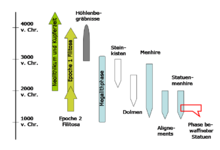Alignments from Palaggiu
The alignments of Palaggiu (also Paddadiu or Pagliaiu) are located near the D48 road from Sartène to Tizzano in the Corse-du-Sud department in Corsica . The largest preserved collection of rows of menhirs in the Mediterranean can be found here.
258 monoliths were excavated between 1964 and 1968 by Roger Grosjean (1920–1975). There are 76 early anthropomorphic menhirs (originated between 1900 and 1400 BC), six anthropomorphic menhirs of the Bronze Age Torreaner and three steles (1600-1000 BC). The rest are stones that cannot be specified due to the weathering.
The alignments consist of seven groups of double rows, the axes of which, with one exception, run in north-south direction. The stones are oriented with the picture side to the east. The much smaller western row of stones is arranged at right angles to it, which Grosjean tries to explain by the fact that these imperfectly worked menhirs were used as storerooms or as storage for discarded stones. On the other hand, the Montagne de Cagna with the Omu di Cagna (a spectacular rocking stone ) can only be seen from this point . At the edge of the site there are five stone boxes (French: Coffre ), some with engravings, four of which were looted and destroyed. The fifth is a few meters from the northern group of alignments in a chaos of boulders. The three steles are, besides the statue menhir "Filitosa V" and that of "Cauria IV", the only ones on which the sword and dagger are depicted. Here, however, there is no sculpted representation, only engraved details, which is why Grosjean calls them "Statues-steles" in contrast to the "Statues-menhirs".
Roger Grosjean's theory
R. Grosjean assigns the three steles to the final phase of the Corsican megalithic culture, despite their more primitive depiction. He also notes that the weapons engraved on the stelae do not match those found in the only largely preserved stone box of the Corsican megaliths. He therefore suspects that, because the war against the Torreans was coming to an end, the artists no longer felt the need to depict an exact copy of the enemy. Grosjean also sees this as evidence for his controversial theory that the megaliths made an image of their enemies in the statues and steles and the anger of the Torreaner over the representations led to the destruction of the images.
See also
literature
- Eugène Bonifay (Red.): Préhistoire de la Corse. Center Regional de la Documentation Pédagogique, Ajaccio 1990, ISBN 2-86620-50-3 .
Web links
Coordinates: 41 ° 33 ′ 25 ″ N , 8 ° 53 ′ 13 ″ E


